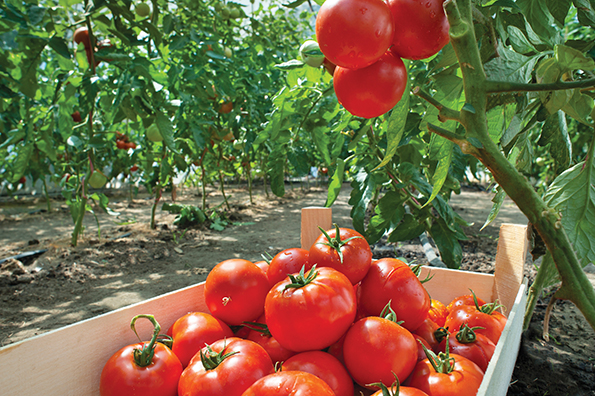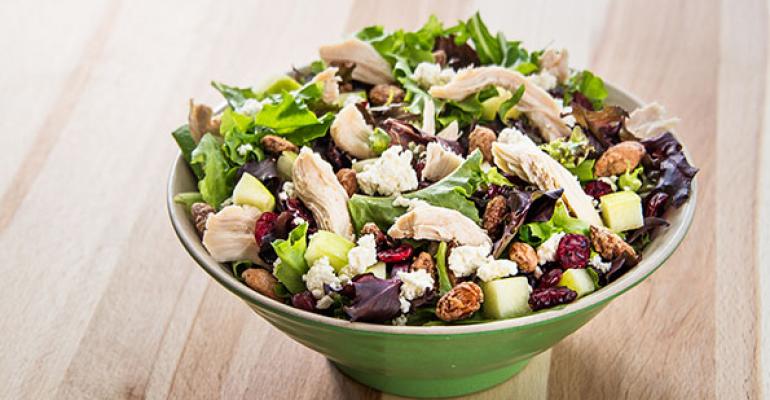When Chipotle Mexican Grill Inc. was forced to go without pork in some restaurants this year, some saw it as a clear sign that America’s food suppliers are not keeping up with the pace of change.
Chipotle, with its emphasis on meat raised without hormones or antibiotics, had suspended a supplier that was not meeting the chain’s animal welfare standards. No other source was immediately available, and the chain took a hit in sales by refusing to compromise by serving conventionally raised pork in the interim.
Indeed, the Denver-based, fast-casual chain eventually had to go to the U.K. to find a pork supplier that would fill the gap, and carnitas is expected to be back on the menu systemwide by the fourth quarter.
Steve Ells, Chipotle’s co-CEO, said the chain would prefer to source domestically, but “the quantity of pork that meets our standards is simply not available right now from domestic suppliers as the vast majority of pork raised in the United States, more than 95 percent, based on our estimates, is not raised to our standards.”
And those standards matter more than ever before — for Chipotle and, increasingly, the industry at large.
This year a torrent of restaurant chains has promised to raise the bar on their own ingredients as consumers increasingly demand fresher food, produce that is local and/or organic, eggs from chickens that have not been kept in cages, dairy produced without growth hormones or meat raised humanely and without the use of antibiotics.

It’s a movement that will only pressure the supply chain further. Many say it will take years for Big Agriculture to adapt a system complicated by politics, government subsidies and shifting global trade winds — not to mention the challenges of climate change.
But change is happening. And it’s coming from restaurant guests, said Marley Hodgson, co-founder of the fast-casual chain MAD Greens, based in Denver.
“In today’s environment, sourcing has become one of the bigger challenges for the restaurant industry because of the way things have gone. Consumer preferences have driven this over the course of the last decade. It started as a slow shift, but became a tidal wave,” he said.
“They want fresher ingredients. They want to know where it’s coming from, and how their food is raised. There’s just a lot more at stake in the sourcing discussion than there used to be.”
Scaling freshness
For big restaurant chains, the shift toward fresher and unprocessed ingredients has been a particular challenge.
The Wall Street Journal recently described a three-year effort by The Wendy’s Co. to find enough blackberries for a new salad the chain plans to offer next summer. Company officials described it as a “slow and painful journey” that involved visiting more suppliers than ever before and coaxing growers to plant more bushes.
Carl’s Jr. launched an All-Natural Burger last year, made with grass-fed, free-range beef raised without added hormones, antibiotics or steroids. But the company was forced to source meat from Australia. And even then, there wasn’t enough beef available to supply sister brand Hardee’s until this year.
The burger was a hit, said Brad Haley, chief marketing officer for Carl’s Jr./Hardee’s parent CKE Restaurant Holdings.
“It seemed to bring in, or perhaps more accurately, bring back consumers who had given up fast food because they simply couldn’t get food like this there, so, obviously, we wanted to introduce the All-Natural Burger at our sister chain Hardee’s as soon as we could,” he said in July. “However, there simply wasn’t enough grass-fed, all-natural beef available to supply both our restaurant chains until now.”
Subway has also faced pressure from the Natural Resources Defense Council and other groups this year to remove from its menu meats raised with the use of antibiotics.
Officials with the Milford, Conn.-based sandwich giant said they are working on it, but “so are many other companies, which makes securing supply challenging for a chain our size.”
Though the 44,000-unit chain hopes to have chicken raised without human antibiotics on the menu by next year, they couldn’t give a timeline for other meats to go antibiotic free. “We cannot provide a date when all the work will get done as the demand is somewhat higher than supply right now,” officials said through a spokeswoman.

Over the next few years, the ingredient landscape across big chains is expected to shift considerably as more players move to sustainable, natural and less processed alternatives.
“It’s not a flash-in-the-pan trend,” said Stacie Sopinka, US Foods’ vice president of product development and innovation. “Within my career, there’s been a massive shift and things will continue to change and evolve.”
The trend, however, is still coming mostly from emerging brands and early adopters, she said. College and university campuses, in particular, are demanding better ingredients.
For broadline distributors like US Foods, its not just about finding the fair trade/organic/all-natural/animal-welfare-friendly product restaurant operators want to serve their customers. It’s about being able to accurately tell that product’s story.
“Foodservice has historically lagged retail in terms of having to provide that information. For retailers, that information is right in front of consumers (on labels),” she said. “For example, if I wanted to purchase only fair trade products, and I want them to come from within a 100-mile radius, that’s a very specific search for products. But that’s something we have to wire ourselves to ensure we can provide.”
Most recently, the demand has been for simpler products, with fewer ingredients, or “things you can pronounce,” said Sopinka.
But the road to offering such products is a journey, not a destination, she added.
“Many companies make commitments that are aspirational,” Sopinka said. “They do that because the path to getting there is not clear. Many of these topics are not black and white. There are trade-offs.”
Growing farmers
As large restaurant chains grapple with shifting consumer tastes, smaller, younger brands are building entire menus around fresh, organic, local and minimally processed ingredients.
These more-nimble brands are also building break-the-mold models for ingredient procurement to ensure the supply will be available as they expand.
Los Angeles-based Tender Greens, for example, has a regional farm as equity partner, working to supply the fast-casual concept as it plots expansion to 30 units by the end of 2016.
The partnership with Oxnard, Calif.-based Scarborough Farms began not long after Tender Greens was founded in 2006.

“With the first few stores we opened, when we needed breathing room around paying back invoices, we traded lettuce for shares in the company,” said Tender Greens co-founder Erik Oberholtzer. “It ended up working for both of us.”
Now with 18 units, Tender Greens is working with Scarborough directly as the restaurant chain expands, but also with a combination of growers like the vertical hydroponic “urban microfarm” Alegria Fresh, which uses “Soxx” farming that is done in raised beds; Go Green, which uses hydroponic indoor growing facilities; and even aeroponic towers on its restaurant patios, where heads of lettuce may be growing right next to guests.
“We need the supply chain to grow with us,” Oberholtzer said. “The lineup of lettuces and herbs Scarborough grows in Oxnard can be replicated using indoor and hydroponics anywhere in the world. We’re modeling that out now.”
Better quality at a premium price
The challenge, of course, is that “it costs money to get the good stuff,” Oberholtzer said. “We like the good stuff and we demand the good stuff. But we’re also cheapskates. We’re chefs who know the cost of things and we don’t like prices that are insulting.”
Hodgson of MAD Greens said consumers are willing to pay a premium for better ingredients — but there is a cap on what they will accept.
“There’s not a huge space to play in terms of the cost increase you can pass on to the consumer,” he said.
Smaller chains, like the 17-unit MAD Greens, don’t have the advantages of volume to negotiate pricing, as bigger chains might, he said.
Distribution is also a challenge.
To go through broadline distributors involves “headaches and jumping through hoops,” he said, all the while knowing that something could throw a wrench in the works, like a rainstorm putting too much sand in the spinach or some type of pest could wipe out an entire crop.
“Then, you have to do a 180 and go running to another source,” he said. “But to be able to shift quickly is not the forte of the big distributors.”
Smaller distributors are inserting themselves into the mix, which is good — but that forces chains to take more deliveries. “That used to be a huge no-no,” said Hodgson.
In Colorado, MAD Greens has been working with Agriburbia, a company that develops urban gardens on unused plots of land. But weather has been a hindrance over the past two years.
Still, fundamentally, for brands like MAD Greens, which are entirely built on the promise of better ingredients, the ability to manage the complexity of the supply chain is an increasingly valuable point of differentiation.
Some brands give lip service to offering better ingredients, Hodgson said.
In Denver, local growers snicker about how their farm’s name is on menus across the city, when only a handful actually buy from the farm, he said.
“But the consumer is getting smarter. You can’t just say you’re doing it, and not walk the walk, as some did a few years ago,” Hodgson said. “Things don’t pass the sniff test like they used to.”
Flexibility is key
Anthony Pigliacampo, co-CEO of Denver-based Modmarket, said restaurant chains will also be forced to give up some of their traditional ways of thinking about ingredients.
For big chains that have been around a while, a big part of the problem is the decades of dependence on overly processed foods designed to simplify processes — as well as the notion that restaurant menus should be exactly the same across multiple markets, according to Pigliacampo.

Modmarket’s menu is built around simple, whole ingredients — local and organic, when possible, but always fresh. What makes that work for the fast-casual Modmarket is being flexible in operations.
Rather than demanding that chicken breasts be a certain size, for example, the company uses random sizes and deals with the differences in the kitchen.
Fundamentally, what Modmarket does is cook, said Pigliacampo.
The chain buys whole, raw ingredients — what Pigliacampo calls shopping around the perimeter of a grocery store where produce, meat and seafood can be found. The restaurants “add value” with the application of culinary skill, using one ingredient in multiple ways.
A sweet potato, for example, will appear across the menu in many forms: shoestringed and fried for the Thai coconut salad, roasted with olive oil or smashed.
“There’s nothing added in terms of preservatives or additives or colorants. We know what goes in it. It’s a potato,” he said. “From the beginning, we’ve always felt it was important to have a menu that was not so exotic that it would paint us into a corner from a supply standpoint.”
Modmarket’s 14 restaurants — with another 10 on deck for next year — have menus that vary by region and season.
“We meet people from other concepts and they see what we’re doing and the common refrain is, ‘Oh my God, it’s so complicated!’ And we say, ‘Exactly!’” said Pigliacampo.
“As we’re scaling, we’re building systems to manage that complexity,” he continued. “I don’t see how you could roll some of these things out in a large, established company. But when you build a company from the ground up doing it, it’s all you know.”
Vision for the future
Oberholtzer sees the food system changing, and he hopes consumers will remain at the forefront of that change.
He recently visited an Amish farm in Pennsylvania that for years had raised tobacco. Now the fields were filled with heirloom tomatoes, zucchini and eggplant and supplying restaurants in Manhattan and Philadelphia.
“When the market is there, these farmers will change to meet the demand,” he said. “Our views, our demands and our money will influence what people grow, how they farm and how they fish.
“More chefs are committed to this way of eating, and there are a lot of dollars being spent on organic and sustainable food now,” he continued. “We want, along with Chipotle and Whole Foods, to continue moving the growers to support our vision of the future, versus the overly processed commodity markets of the past.”
Contact Lisa Jennings at [email protected].
Follow her on Twitter: @livetodineout

